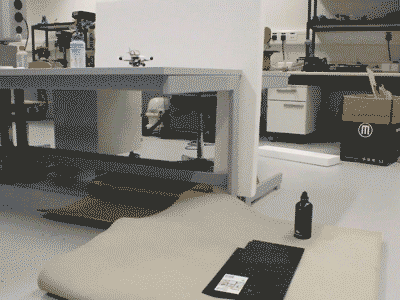Os-like drones lift weights by helping themselves abdomen
- Transfer

You may know that wasps can brainwash cockroaches or that their bite is one of the most painful sensations on Earth, and that the real scientific advice for those who have been stung by a wasp is simply to wallow and yell until the pain will pass. Less well known is the fact that wasps are capable of carrying unexpectedly large loads for such small creatures.
Microdrones are able to lift only their own weight. If we need to create flying robots capable of carrying heavy objects, but we don’t want to make them the size of pterodactyls, engineers will have to come up with some new ways to lift loads. Therefore, the developers of drones turned to wasps, and are developing creative ways to use our environment as a secret weapon of robotics.
If the wasp bites and cuts down prey, which can not raise, it still drags. It allows it arolium , a pad on the legs, helping to cling to the surface. Together with the claws, the aroli allows the wasps to manipulate objects with which they cannot simply fly away. Therefore, they sting prey, exceeding their weight.
Engineers want drones to do that too. Therefore, the new class of robots FlyCroTugs copies some features of these irritable flyers. At first glance, these robots look like ordinary quadcopters that fit in the palm of your hand. Their secret is hidden in their belly. Being on the ground, one version of the apparatus uses hooks, clinging to the bumps and hollows of the surface, like wasps with claws, while the other uses a pad that adheres to a flat surface. Then these devices can use a tiny winch, with the help of which they are able to lift and haul cargo, heavier than them more than 40 times.

The physics of hooks is fairly simple - fixing with a lever. “We are just trying to build these hooks next to each other, so that each of them finds his own protrusion, and together they can pull harder than one hook,” says Stanford robotics engineer Matthew Estrada, who describes these devices in the journal Science Robotics.
The physics of the pads are more tangled. This technology was created under the influence of the paws, not of the wasps, but of the gecko, and it is not particularly new - Stanford researchers have already used it, for example, to develop a capture that can ever grab space debris in orbit. But the forces acting in it can give FlyCroTug gecko abilities and lifting opportunities comparable to insects.

This trick is based on van der waals forces. The material on the bottom of the drone is full of silicone scallops. Coming in contact with a flat surface tangentially, the scallops line up in one direction (see the animation below). “They all go to bed and come into very close contact with what they were pressed to,” says Estrada. The contact is so close that each scallop begins to be attracted to the surface at the molecular level. Since there are a lot of them in the material, these forces are summed up and give excellent adhesion.

This is how geckos run on the walls, and FlyCroTugs is able to lift weights that exceed its weight 40 times. While the robot is still on the surface of, say, the table, it can use the forces of van der Waals, lifting objects that are much heavier than himself by a winch. For example, a bottle of water.
To raise the heavier things you can use several of these tiny robots. This may be more useful than simply scaling drones to increase their energy. Such an approach may reduce the cost of their production and allow them, if necessary, to penetrate into small spaces. Who needs mass, if you can take a number?
Unlike previous models of drones, made under the influence of natural ideas, FlyCroTug was inspired by the wasp not only as a flying animal, but also in the whole system of its work as a whole. “Flying insects can’t just fly when it comes to moving objects,” says Caltech robot engineer Sun Joe Chan, who developed a bat-like drone.. They are also able to carry cargo that they cannot lift into the air. "This is a very interesting innovation and addition to this work."
In other words, using motion on the surface or other environmental features can help make new robots better. Most robots either roll on the ground or fly through the air without interacting with the environment. FlyCroTugs is completely different: they use the environment to increase their efficiency. The surface can be useful not only for navigation, it can be used as a tool for lifting loads.

This new ability to lift cargo is not only useful for dragging large objects. Two robots can work together on such complex manipulations as opening a door. The first drone steals up on a position and puts a hook with a spring under a door. The second robot hooks the hook. Then the second robot, holding the door, pulls the handle down until the first opens the door.
The idea is that sticking groups of robots can handle tasks that are too difficult for individual robots. “You can imagine individual robots as moves in a chess game,” says Estrada. “How can you apply these forces in different directions to perform any complex task?” Instead of loading the complex functions of a sophisticated and expensive robot, in some cases it will be easier to coordinate the work of several bots.
Or at some point, researchers can combine these two campaigns - hooks for hooking coarse materials, and pads for smooth ones - in the same drone, which works well on different surfaces.
Just do not need to attach his sting. Let's leave this path unexplored.
